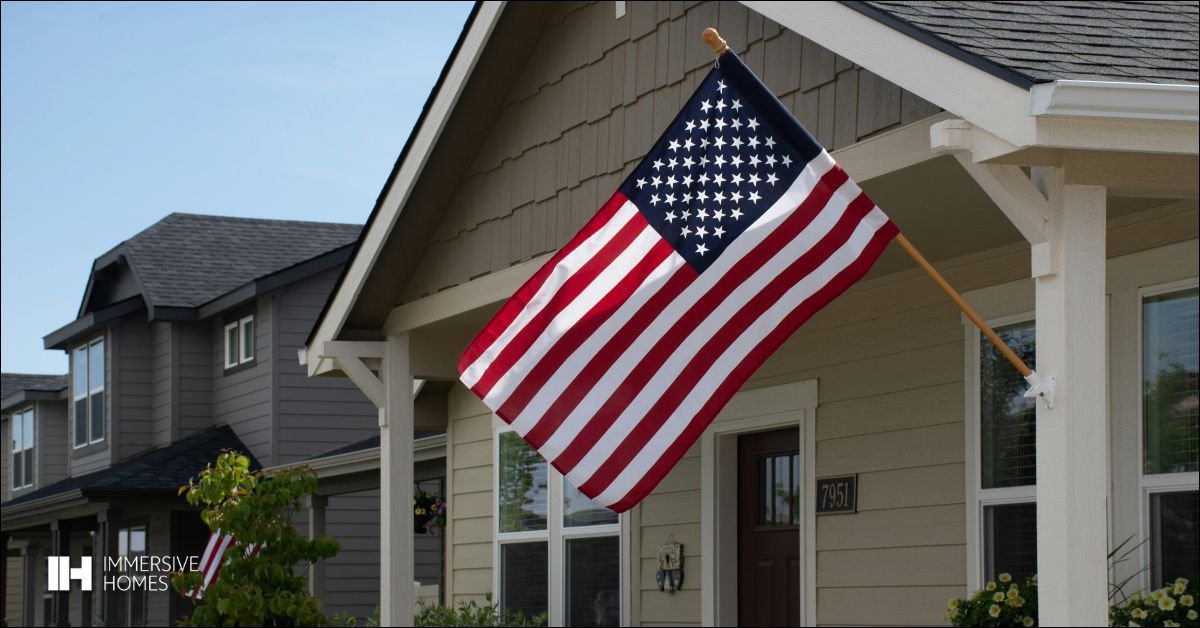
U.S.-built homes are gaining attention again, not just as practical housing solutions but as a reflection of national pride, economic strength, and long-term quality.
With Independence Day approaching, it’s the perfect time to consider how American-made materials, local labor, and dependable craftsmanship are reshaping how we think about building and buying homes.
While overseas options once seemed more affordable, recent events have shown the value of staying close to home.
What Qualifies a Home As Made in America?
In homebuilding, "Made in America" goes beyond marketing. It means using materials, labor, and design expertise sourced in the United States. U.S.-built homes often include American-made lumber, insulation, concrete, windows, and even appliances.
Builders work with local electricians, HVAC installers, plumbers, and roofers who follow U.S. safety and labor standards.
According to the National Association of Home Builders (NAHB), more than 90% of the materials used in a typical new home are available from U.S. suppliers. Still, many large developers choose imports to cut costs.
Smaller builders focused on quality are increasingly going the other way by choosing local materials and workers.
How Does Buying a U.S.-Built Home Help the Economy?
Buying a U.S.-built home helps your local economy. Construction is one of the largest job creators in the U.S., employing over 8 million people in 2024.
Each home supports a network of American businesses like lumber yards, steel plants, and interior finishers.
A 2023 report from the Economic Policy Institute found that for every $1 million spent on residential construction, about 11 full-time jobs are created.
That means your purchase supports real people, many of whom live in your community.
Why Are Local Builds Safer and More Reliable?
The COVID-19 pandemic exposed how fragile global supply chains can be. Many homes built with imported materials were delayed for months.
By contrast, US-built homes had better access to materials and faced fewer interruptions.
Domestic building also follows strong safety guidelines.
Workers are protected by OSHA rules, and the construction process is monitored through local inspections. These checks help give homeowners peace of mind.
What Makes U.S.-Built Homes Higher Quality?
US construction is known for durability, thanks to strong building codes. From hurricane zones in Florida to snowy areas in Colorado, US-built homes are designed for local weather.
This can help reduce long-term repairs. Some builders also use techniques like closed-cell spray foam insulation and advanced framing to improve strength and energy savings.
According to Energy Star, homes built to today's standards use 20 to 30% less energy than homes built just ten years ago.
How Do American Values Show Up in Homebuilding?
Many US-built homes carry the personal touch of the builder. Homeowners often know who built their home, and they can ask questions directly.
That level of transparency is rare with overseas prefab homes. This connection can build trust. People take pride in their work, and it shows in the details, from the layout to the finishing.
Are U.S.-Built Homes Worth the Cost?
It’s true that US-built homes can cost more upfront due to higher labor and material prices. But over time, they often hold value better and cost less to maintain.
Homes built with high-quality materials typically last longer and need fewer repairs. Some energy-efficient homes even qualify for discounts on insurance
Homes with energy upgrades can sell for up to 5% more than similar homes.
Why Is Independence Day a Good Time To Talk About U.S.-Built Homes?
Holidays like July 4th have long been tied to American industry. After World War II, programs like the GI Bill funded a huge wave of new homes, many built by veterans using American materials.
Today, interest in supporting American-made products is growing again. A 2023 Consumer Reports survey showed that 78% of Americans prefer buying items made in the U.S., even if they cost more.
Why Do U.S.-Built Homes Matter More Than Ever?
This July 4th, consider how your next home can reflect your values. US-built homes offer more than just a place to live—they support local jobs, maintain high-quality standards, and help build stronger communities.
Looking ahead, choosing homes built in the U.S. by skilled local workers is not only a practical decision but also one that reflects integrity and long-term value. It’s a choice rooted in quality, reliability, and pride.
If you're planning to build or buy a home, now is the perfect time to explore what system-built homes have to offer. Contact Immersive Homes to see how we can help you succeed with a system-built home that meets your needs and aligns with your values.
FAQs
What are the key benefits of U.S.-built homes compared to imported or prefab alternatives?
U.S.-built homes are known for high-quality craftsmanship, strict code compliance, and the use of locally sourced materials. They also support the national economy by creating jobs and reducing risks from overseas supply chain disruptions.
How does factory-built or modular construction support sustainability and efficiency
Factory-built homes are constructed in controlled environments that minimize material waste and energy use. This process allows for faster building times, higher precision, and reduced environmental impact compared to traditional site-built methods.
Why do many American homes still use wood framing rather than steel or concrete?
Wood remains popular because it is widely available, cost-effective, and offers excellent insulating properties. Builders are also more familiar with wood, making it easier to construct, repair, and adapt compared to steel or concrete.
Can U.S.-built homes qualify for green building certifications and offer energy savings?
Yes, many U.S.-built homes can meet standards like LEED, ENERGY STAR, or Passive House by integrating advanced insulation, energy-efficient windows, and sustainable materials. These features lower utility costs and provide long-term energy savings for homeowners.
How does buying American-made construction materials and labor support the national economy and innovation?
Purchasing American-made materials strengthens local industries, supports skilled labor, and keeps money circulating within U.S. communities. It also encourages innovation and reduces dependence on imports, leading to more resilient and reliable construction practices.